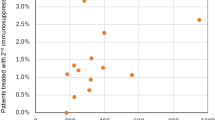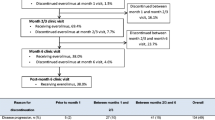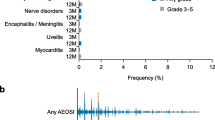Abstract
Background
There have been few reports of the differences in safety between the mammalian target of rapamycin inhibitors, everolimus and temsirolimus. The purpose of this study is to compare the adverse event profiles of both agents and to estimate the risk factors for non-infectious pneumonitis in patients with advanced renal cell carcinoma on the basis of our real-world clinical experience.
Methods
Data from 218 consecutive patients that received either everolimus or temsirolimus for advanced renal cell carcinoma at five Japanese centers were retrospectively analyzed. Chi-squared test and univariate and multivariate logistic regression analyses were performed to investigate the differences in adverse event profiles and the risk factors associated with non-infectious pneumonitis, respectively.
Results
A total of 196 patients were evaluable. In the everolimus group compared with temsirolimus, stomatitis (56 vs 30 %, p < 0.001) and non-infectious pneumonitis (38 vs 22 %, p = 0.018) were more frequently observed, and asthenia (11 vs 23 %, p = 0.027), rash (20 vs 36 %, p = 0.018), and fatigue (33 vs 48 %, p = 0.032) occurred less frequently in all grades. On multivariate analysis, male gender (odds ratio 3.65; 95 % confidence interval 1.44–9.26, p = 0.007) and everolimus treatment (odds ratio 2.00; 95 % confidence interval 1.01–3.96, p = 0.046) were significantly associated with development of non-infectious pneumonitis.
Conclusion
Our findings suggest that adverse event profiles may differ between everolimus and temsirolimus and that non-infectious pneumonitis may occur more frequently in patients treated with everolimus than temsirolimus. Further investigations are needed to confirm these results.
Similar content being viewed by others
References
Ciuffreda L, Di SC, Incani UC et al (2010) The mTOR pathway: a new target in cancer therapy. Curr Cancer Drug Targets 10:484–495
Meric-Bernstam F, Gonzalez-Angulo AM (2009) Targeting the mTOR signaling network for cancer therapy. J Clin Oncol 27:2278–2287
Benjamin D, Colombi M, Moroni C et al (2011) Rapamycin passes the torch: a new generation of mTOR inhibitors. Nat Rev Drug Discov 10:868–880
Lebwohl D, Thomas G, Lane HA et al (2011) Research and innovation in the development of everolimus for oncology. Expert Opin Drug Discov 6:323–338
Husseinzadeh HD, Garcia JA (2011) Therapeutic rationale for mTOR inhibition in advanced renal cell carcinoma. Curr Clin Pharmacol 6:214–221
Pantuck AJ, Seligson DB, Klatte T et al (2007) Prognostic relevance of the mTOR pathway in renal cell carcinoma: implications for molecular patient selection for targeted therapy. Cancer 109:2257–2267
Motzer RJ, Escudier B, Oudard S et al (2008) Efficacy of everolimus in advanced renal cell carcinoma: a double-blind, randomised, placebo-controlled phase III trial. Lancet 372:449–456
Motzer RJ, Escudier B, Oudard S et al (2010) Phase 3 trial of everolimus for metastatic renal cell carcinoma: final results and analysis of prognostic factors. Cancer 116:4256–4265
Hudes G, Carducci M, Tomczak P et al (2007) Temsirolimus, interferon alfa, or both for advanced renal-cell carcinoma. N Engl J Med 356:2271–2281
Kovarik JM, Hartmann S, Figueiredo J et al (2002) Effect of food on everolimus absorption: quantification in healthy subjects and a confirmatory screening in patients with renal transplants. Pharmacotherapy 22:154–159
Kovarik JM, Kahan BD, Kaplan B et al (2001) Longitudinal assessment of everolimus in de novo renal transplant recipients over the first post-transplant year: pharmacokinetics, exposure–response relationships, and influence on cyclosporine. Clin Pharmacol Ther 69:48–56
Kirchner GI, Meier-Wiedenbach I, Manns MP (2004) Clinical pharmacokinetics of everolimus. Clin Pharmacokinet 43:83–95
Klumpen HJ, Beijnen JH, Gurney H et al (2010) Inhibitors of mTOR. Oncologist 15:1262–1269
Kovarik JM, Hartmann S, Figueiredo J et al (2002) Effect of rifampin on apparent clearance of everolimus. Ann Pharmacother 36:981–985
Kovarik JM, Beyer D, Bizot MN et al (2005) Blood concentrations of everolimus are markedly increased by ketoconazole. J Clin Pharmacol 45:514–518
Boni J, Leister C, Burns J et al (2007) Pharmacokinetic profile of temsirolimus with concomitant administration of cytochrome p450-inducing medications. J Clin Pharmacol 47:1430–1439
Boni JP, Leister C, Burns J et al (2008) Differential effects of ketoconazole on exposure to temsirolimus following intravenous infusion of temsirolimus. Br J Cancer 98:1797–1802
Boni JP, Hug B, Leister C et al (2009) Intravenous temsirolimus in cancer patients: clinical pharmacology and dosing considerations. Semin Oncol 36(Suppl 3):S18–S25
Faivre S, Kroemer G, Raymond E (2006) Current development of mTOR inhibitors as anticancer agents. Nat Rev Drug Discov 5:671–688
O’Donnell A, Faivre S, Burris HA III et al (2008) Phase I pharmacokinetic and pharmacodynamic study of the oral mammalian target of rapamycin inhibitor everolimus in patients with advanced solid tumors. J Clin Oncol 26:1588–1595
Raymond E, Alexandre J, Faivre S et al (2004) Safety and pharmacokinetics of escalated doses of weekly intravenous infusion of CCI-779, a novel mTOR inhibitor, in patients with cancer. J Clin Oncol 22:2336–2347
Hidalgo M, Buckner JC, Erlichman C et al (2006) A phase I and pharmacokinetic study of temsirolimus (CCI-779) administered intravenously daily for 5 days every 2 weeks to patients with advanced cancer. Clin Cancer Res 12:5755–5763
Ando M, Okamoto I, Yamamoto N et al (2006) Predictive factors for interstitial lung disease, antitumor response, and survival in non-small-cell lung cancer patients treated with gefitinib. J Clin Oncol 24:2549–2556
Paez JG, Jänne PA, Lee JC et al (2004) EGFR mutations in lung cancer: correlation with clinical response to gefitinib therapy. Science 304:1497–1500
Morelon E, Stern M, Israël-Biet D et al (2001) Characteristics of sirolimus associated interstitial pneumonitis in renal transplant patients. Transplantation 72:787–790
Bellmunt J, Szczylik C, Feingold J et al (2008) Temsirolimus safety profile and management of toxic effects in patients with advanced renal cell carcinoma and poor prognostic features. Ann Oncol 19:1387–1392
Acknowledgments
We would like to thank all the patients, investigators, and staff from participating sites.
Conflict of interest
Kiyohide Fujimoto has received research grants from Novartis and Pfizer; Tsuneharu Miki has received research grants from Novartis and Pfizer; Hirotsugu Uemura has received research grants from Novartis and Pfizer; the other authors have no conflict of interest.
Author information
Authors and Affiliations
Corresponding author
About this article
Cite this article
Nozawa, M., Ohzeki, T., Tamada, S. et al. Differences in adverse event profiles between everolimus and temsirolimus and the risk factors for non-infectious pneumonitis in advanced renal cell carcinoma. Int J Clin Oncol 20, 790–795 (2015). https://doi.org/10.1007/s10147-014-0764-5
Received:
Accepted:
Published:
Issue Date:
DOI: https://doi.org/10.1007/s10147-014-0764-5




